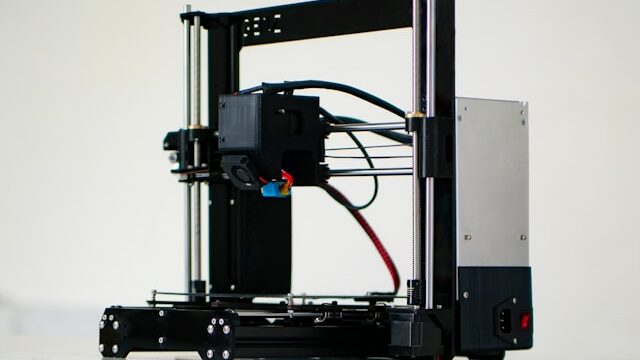Are you wondering if it’s possible to create 3D prints for babies? At Imprimy, we are here to answer all your questions.

What are the applications of 3D printing for babies?
3D prints can be used to create medical devices, accessories, or clothing for babies.
3D printed medical and orthopedic devices for babies
3D printed medical and orthopedic devices for babies represent a significant advancement in the field of personalized medicine. Thanks to this technology, it is now possible to create customized solutions tailored to the specific needs of each child, particularly for conditions like congenital deformities or fractures.
3D printing allows for the production of prosthetics, splints, or lightweight casts that are comfortable, perfectly fitted, and improve medical monitoring, while reducing pain for infants. Moreover, the use of biocompatible and durable materials enhances the safety and effectiveness of treatments, while offering lower production costs compared to traditional devices.
3D printed baby accessories
3D printed baby accessories offer a wide range of innovative and customized options to meet the needs of parents. This technology allows the design of items such as pacifiers, teething rings, bottles, toys, or even custom clothing, tailored to the specific shape and preferences of each baby.
The major advantage of 3D printing lies in the ability to create lightweight, ergonomic products made with safe and biocompatible materials, thus reducing risks to the child’s health.
Additionally, these accessories can be easily personalized in terms of colors and designs, offering a unique touch while meeting the highest safety standards.
3D printed clothing and shoes for babies
3D printed clothing and shoes for babies represent a true revolution in the children’s fashion industry. Thanks to 3D printing, it is now possible to create perfectly fitted garments, offering greater freedom of movement and optimal comfort for toddlers.
3D printed shoes can be designed to precisely fit the shape of the child’s foot, ensuring better stability and support for growth. These products can also be made with flexible and breathable materials, reducing the risk of irritation or discomfort.
Moreover, this technology allows for customized designs and optimizes production costs, all while adhering to strict standards of durability and safety.
What are the advantages of 3D printing for babies?
3D printing allows for the customization of items for babies and helps save time and money, as long as certain safety requirements are met.
Customization and comfort of 3D prints for babies
Customization and comfort are major advantages of 3D printing for babies, allowing the creation of products that are perfectly suited to their unique needs. With this technology, it is possible to design medical devices, clothing, shoes, or accessories that fit the shape and specific characteristics of each baby, providing an optimal fit and better ergonomics.
Customization goes beyond aesthetics, also enhancing comfort by using soft, breathable, and hypoallergenic materials, reducing the risk of irritation or discomfort. Additionally, this approach addresses medical needs, such as for babies with deformities or orthopedic needs, while ensuring maximum safety and freedom of movement.
The time and cost savings of 3D printing for babies
The time and cost savings offered by 3D printing for babies are significant, benefiting both parents and healthcare professionals. By enabling the quick and customized production of devices or accessories, 3D printing reduces manufacturing time compared to traditional methods, which is especially advantageous for urgent needs.
Additionally, it allows for the creation of products at lower costs, minimizing waste and optimizing material usage. The customization and precision of 3D production also eliminate the need for costly modifications or product returns, making the process more efficient and cost-effective. Thus, this technology not only helps reduce production costs, but also makes tailored solutions more accessible to families.
Safety and quality of 3D prints for babies
Safety and quality of 3D prints for babies are essential priorities, as these products must meet strict standards regarding health and well-being. The materials used for 3D printing are carefully selected to be biocompatible, hypoallergenic, and non-toxic, ensuring the absence of harmful substances that could harm the sensitive skin or health of infants. Additionally, thanks to the precision of 3D manufacturing, each product can be optimally tailored to the child’s needs, minimizing the risks of irritation or discomfort.
Regarding durability, 3D printed objects can be designed to be both flexible and resilient, ensuring increased longevity and strength while maintaining strict quality standards. These technologies thus allow for the combination of customization, safety, and high performance.
What are the limitations of 3D printing for babies?
3D prints may pose potential risks for babies if regulations and safety standards are not properly followed when using these technologies.
Standards and regulations for 3D printed products intended for babies
Standards and regulations for 3D printed products intended for babies are strictly defined to ensure their safety and quality. These products must adhere to strict guidelines, including those set by organizations such as CE (Conformité Européenne) for products intended for the European market. They must be made from non-toxic, hypoallergenic, and biocompatible materials to avoid any health risks.
Additionally, 3D printed products must undergo resistance, durability, and non-toxicity tests in compliance with current regulations to ensure they do not pose a danger, especially to the sensitive skin of infants. Finally, specific requirements also concern the conformity of products with safety standards related to baby toys and accessories, aimed at preventing risks such as choking, injury, or allergies.
The accessibility of 3D printing technology for babies
The accessibility of 3D printing technology for babies is gradually improving, although it remains limited in certain areas. Thanks to the decrease in production costs and the evolution of 3D printers and available materials, more and more healthcare professionals, industries, and even parents have access to this technology.
3D printed products, such as medical devices, accessories, or clothing, can now be made at more affordable prices, making the technology more accessible to a larger number of families. Additionally, online platforms offer the ability to customize and order these products in a simple and fast way.
However, access to highly specialized 3D solutions, such as those for complex medical care, is sometimes limited by the cost or availability of equipment and qualified experts. Nonetheless, ongoing progress in the field gives hope for increased accessibility in the near future.
The cost of specialized materials for creating 3D prints for babies
The cost of specialized materials for creating 3D prints intended for babies can vary depending on the nature of the products being made and the specific safety requirements. The materials used must be biocompatible, hypoallergenic, and often flexible, which can make them more expensive than standard materials.
Materials such as medical-grade plastic, silicone, or soft composites may be necessary to ensure the safety and comfort of babies, and these high-quality materials are generally more costly. Additionally, 3D manufacturing processes require specialized equipment, which can increase the overall production cost.
However, although the price of specialized materials is higher, the ability to produce customized and tailored objects often offsets these costs, especially with the reduction of waste and the optimization of manufacturing processes.
Conclusion: 3D Printing for Babies
3D printing for babies offers numerous benefits, from customization and comfort to cost savings and improved safety. This technology enables the creation of medical devices, accessories, clothing, and shoes that are tailored to each baby’s specific needs, ensuring a better fit, enhanced comfort, and more effective treatments.
While the accessibility of 3D printing continues to improve, there are still challenges, including the cost of specialized materials and the need for compliance with safety regulations. However, the ongoing advancements in technology and material development make it more feasible for parents and healthcare professionals to access these innovative solutions.
Ultimately, 3D printing represents a significant step forward in providing personalized and affordable products that contribute to the well-being of babies, making it a promising field for the future of infant care.
Image generated by DALL·E, an artificial intelligence model developed by OpenAI.
The articles published on Imprimy.com are for informational purposes only. They are intended to provide general advice and information related to 3D printing. Imprimy.com cannot be held responsible for the results obtained or the consequences arising from the application of the shared information. We recommend always checking the specific instructions for your hardware and materials before use.


